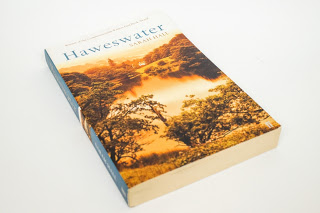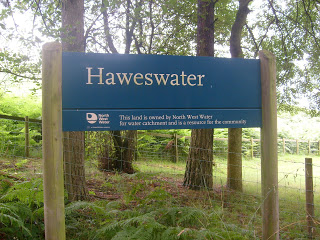By K D Grace
Because I’ve spent the last year and a
half working on my erotic paranormal Lakeland Heatwave Trilogy, I’ve made it a
point to check out anything that might contain valuable information about the
Lake District, and I take loads and loads of pictures each time I visit the
Lakes. I’ve only recently launched Elemental
Fire, the last book in the trilogy, and am definitely feeling some
empty nest syndrome, so it was only natural that when I came across Sarah
Hall’s novel, Haweswater,
I had to read it. Haweswater is an
older book, written long before I knew anything about the English Lakes. Hall’s
is a historic novel set just before and during the time the dam was
being built which created the Haweswater Reservoir.
Haweswater used to be a natural lake
with a tongue of land out in the middle that nearly divided the lake in two,
forming what was then known as High Water and Low Water. The reservoir was built
in the then remote valley of Mardale, with the controversial construction beginning
in 1929, after Parliament passed an act giving the Manchester Corporation
permission to build the reservoir to supply water for Manchester. The valley of
Mardale was populated by the farming villages of Measand and Mardale Green and
the construction of the reservoir meant that these villages would be flooded
and lost, and the people who lived there would have to relocate. There was no
compensation, no help, no recourse.
Hall’s novel is the story of the love
affair between the engineer sent to supervise the project and a local farmer’s
daughter who was born and raised in the valley and loved the land she’d grown
up on. Their tale is set against the tragedy of the land itself.
In 1976 there was a severe drought and,
after forty years of being totally submerged in the reservoir, the village of
Mardale Green once again made an appearance. Before the valley was flooded, the
villages were demolished with explosives and everything that might float and might
cause problems for the water extraction channels in the dam had to be removed. So
what remained was the foundations, the dry stone walls and, amazingly enough,
the bridge over what was once Mardale Beck. Several times since then when there
have been severe droughts, the village of Mardale Green has been exposed, and
when that happens, tourists come from all over to get a rare glimpse of what
was lost. After reading the novel, I did some research on my own and found this
site that had pictures of the villages and the farms before they were flooded
and also pictures of the remains exposed by the drought. http://www.mardale.green.talktalk.net/
This might seem a strange topic to bring
up on the Erotica Readers and Writers Blog, but my reasons are simple. The
story moved me, more deeply than I’ve been moved in a very long time. Hall
created a powerful relationship between her two main characters with some of
the most simply written, most visceral sex scenes I’ve ever read. Hall created
a world which was so much more than concrete and yet so very, very fragile and
fleeting. She pulled me in and held me in that space where characters interact
intimately, not only with each other, but with the landscape. I found myself
thinking that if those two characters, Janet Lightburn and Jack Liggett, had
been in any other place, in any other setting, their relationship would have
had nowhere near the impact, nor the magnetic pull to me as a reader.
One of my heroes, AlfredWainwright had this to say about the construction of the Haweswater dam in
his A Pictorial Guide to the Lakeland Fells:
If
we can accept as absolutely necessary the conversion of Haweswater [to a
reservoir], then it must be conceded that Manchester have done the job as
unobtrusively as possible. Mardale is still a noble valley. But man works with
such clumsy hands! Gone for ever are the quiet wooded bays and shingly shores
that nature had fashioned so sweetly in the Haweswater of old; how aggressively
ugly is the tidemark of the new Haweswater!
I think Wainwright might have found the work of
Sarah Hall’s hands much less clumsy, much more eloquent in her recreation of
the Mardale Valley as it was before the dam. Her novel seems such a fitting
tribute to a place that now only makes its appearance in dry times, when both
people and the land are thirsty. There seems to be something vindicating and
something accusing, and at the same time something quietly hopeful, in a place
that reveals itself all these years later in such a dramatic way, in a place
that won’t stay buried, won’t stay hidden, in a place that inspires maybe even
more because it’s hidden most of the time. There’s something almost magical in
a place that was nearly lost from memory, but just keeps coming back.
After I’d read Hall’s novel, I went back through my
pictures of the fell walks we’ve done near Haweswater and found something that
still gives me a goose bumps whenever I look at it. It’s a picture of my
husband, Raymond, standing above Haweswater Reservoir on our 5th day
walking the Wainwright Coast to Coast Walk. We’d spent the day walking in the
mist and rain and had been cold and wet all day long. We had descended from Kidsty
Pike, out of the mist and were coming down to follow the lake shore of
Haweswater to the village of Burnbanks. Burnbanks itself didn’t exist until the
dam was built, than it was quickly assembled as a pre-fab village for the
workers building the dam. But it’s the view behind Raymond, in this photo, that
stuns me and moves me, that I didn’t even think about until I read Sarah Hall’s
book, that I didn’t even notice when I took the picture.
Behind Raymond and to the right is Mardale Head. If
you look closely, you can see where the dry stone walls fall away into the
waters of the lake. If we could have turned back time, if we’d been standing
there in 1929, it would have been the village of Mardale Green in the photo
below Raymond rather than the grey waters and the vanishing stone walls. So
much is hidden in this photo, and so much is revealed.
I’m not drawing any parallels for writers. There is
no moral to the story, only that there is a story that I wanted to share with
you, only that I’ve been moved by another writer’s words and by a place that
conceals so very much more than it reveals.






Hello, K.D.,
This tale is remarkably similar to the story of Quabbin Reservoir in western Massachusetts, where I lived for many years. Four towns were dismantled and moved. The remains were submerged under the rising waters (about the same time period, too, I believe).
I recall hiking in the Quabbin Reservation one dry summer and seeing old roads lined with stone walls, running along and then disappearing into the water. The eerie sense of loss stuck with me for years. I used the Quabbin area as part of the setting for my paranormal Necessary Madness at least partially because, it's haunted by the ghosts of drowned lives.
Wonderful post!
Wonderful post, wonderfully written. Thanks so much KD
Thank you, Lisabet and RG! It was a post I couldn't NOT write after reading the book and having been there.
I knew that Haweswater wasn't the only place towns were dismantled and submerged when a dam was built, Lisabet, but as you say, it's so haunting to think not only of the ghosts of drowned lives, but the ghosts of the towns and the way of life itself. What a choice to make, to drown one world to furnish water for another. The area is so stunning. I hope to go back and wander around this summer — much more mindfully now that I know more details of the place.
Interesting post, & the photos add so much! This is an unusual topic here at ERWA, KD.